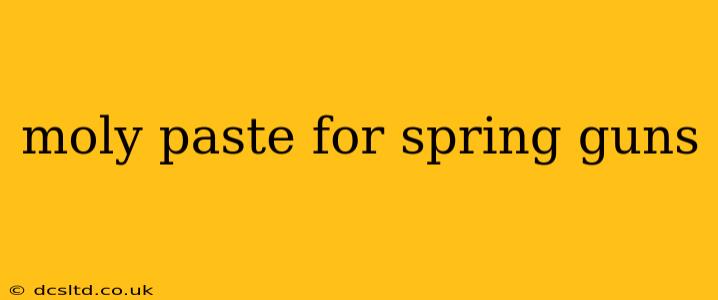Moly paste, a molybdenum disulfide-based lubricant, is often touted as a superior choice for lubricating the springs and moving parts of airguns, including spring-piston guns. Its unique properties make it a popular choice among airgun enthusiasts, but understanding its benefits and proper application is key to maximizing its effectiveness and extending the life of your firearm. This guide will delve into the specifics of using moly paste in spring guns.
What is Moly Paste and Why Use It in Spring Guns?
Moly paste is a high-performance lubricant composed primarily of molybdenum disulfide (MoS2). Unlike traditional oil-based lubricants, moly paste forms a dry, solid film that adheres exceptionally well to metal surfaces. This film provides excellent lubrication, even under extreme pressure and temperature conditions found within a spring-powered airgun. Here's why it's favored for spring guns:
- High-Pressure Lubrication: Spring guns generate significant force during the cocking and firing cycles. Moly paste’s ability to withstand this pressure ensures smooth operation and prevents wear and tear on critical components.
- Reduced Friction: The dry film lubrication minimizes friction between moving parts, leading to smoother operation, reduced wear, and potentially increased shot consistency.
- Protection Against Wear: The tenacious film acts as a barrier, preventing metal-on-metal contact and protecting against abrasion and corrosion.
- Temperature Stability: Moly paste retains its lubricating properties over a wide temperature range, making it suitable for various climates and shooting conditions.
- Extended Spring Life: By reducing friction and wear, moly paste can contribute to a longer lifespan for your airgun's mainspring.
How to Apply Moly Paste to Your Spring Gun?
Applying moly paste correctly is crucial for maximizing its benefits. Too little won't provide adequate lubrication, while too much can attract dirt and debris.
- Disassembly: Carefully disassemble your airgun, following the manufacturer's instructions. This typically involves removing the stock and accessing the spring and piston assembly.
- Cleaning: Thoroughly clean all parts with a suitable degreaser and compressed air to remove any old lubricant, dirt, or debris. Ensure everything is completely dry before applying moly paste.
- Application: Apply a very thin, even layer of moly paste to the surfaces that experience friction during operation. This usually includes:
- The piston seal: Apply a small amount to the surface of the piston seal that contacts the cylinder.
- The piston's bearing surfaces: Lubricate the points where the piston moves within the cylinder.
- The spring's contact points: Apply sparingly to areas where the spring contacts other components.
- Reassembly: Carefully reassemble the airgun, making sure all parts are correctly aligned and seated.
What Are the Alternatives to Moly Paste?
While moly paste is a popular choice, other lubricants can also be used, each with its own set of advantages and disadvantages. These include:
- Silicone-based lubricants: Offer good lubrication but may break down under high pressure.
- Synthetic greases: Provide better protection than silicone-based lubricants but may be less effective under extreme pressures.
- Specialized airgun lubricants: Many manufacturers produce lubricants specifically designed for airguns, often containing a blend of ingredients tailored to withstand the pressures and stresses involved.
Is Moly Paste Safe for All Spring Guns?
While generally safe, always refer to your airgun's manufacturer's instructions before using any lubricant. Some manufacturers may specify particular lubricants or advise against the use of certain types.
Can I Use Too Much Moly Paste?
Yes, using excessive moly paste can lead to several problems:
- Increased fouling: Excess paste can attract dirt and debris, leading to increased friction and potential malfunctions.
- Reduced performance: Excess paste can create unnecessary resistance within the mechanism.
- Build-up: Excess paste can build up and solidify, causing issues with the airgun's operation.
How Often Should I Relubricate My Spring Gun with Moly Paste?
The frequency of relubrication depends on factors such as usage, environmental conditions, and the type of moly paste used. A general guideline is to inspect and relubricate your spring gun every few hundred shots, or as needed. Pay close attention to signs of wear or increased friction.
By understanding the benefits, proper application, and potential pitfalls of using moly paste, you can ensure your spring gun performs optimally and enjoys a long, trouble-free life. Remember, safety and following manufacturer's instructions are paramount.
